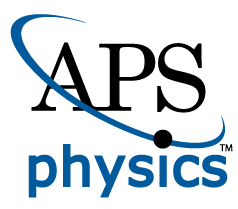http://join2-wiki.gsi.de/foswiki/pub/Main/Artwork/join2_logo100x88.png
Perturbative Quantum Monte Carlo Method for Nuclear Physics
Lu, B.-N. (Corresponding author) ; Li, N. ; Elhatisari, S. ; Ma, Y.-Z. ; Lee, D. ; Meißner, U.-G.FZJ*
2022
APS
College Park, Md.
This record in other databases: 

Please use a persistent id in citations: http://hdl.handle.net/2128/32278 doi:10.1103/PhysRevLett.128.242501
Abstract: While first order perturbation theory is routinely used in quantum Monte Carlo (QMC) calculations, higher-order terms present significant numerical challenges. We present a new approach for computing perturbative corrections in projection QMC calculations. We demonstrate the method by computing nuclear ground state energies up to second order for a realistic chiral interaction. We calculate the binding energies of several light nuclei up to 16O by expanding the Hamiltonian around the Wigner SU(4) limit and find good agreement with data. In contrast to the natural ordering of the perturbative series, we find remarkably large second order energy corrections. This occurs because the perturbing interactions break the symmetries of the unperturbed Hamiltonian. Our method is free from the sign problem and can be applied to QMC calculations for many-body systems in nuclear physics, condensed matter physics, ultracold atoms, and quantum chemistry.
Note: We gratefully acknowledge funding by NSAF (Grant No. U1930403), the Deutsche Forschungsgemeinschaft (DFG, German Research Foundation) and the NSFC through the funds provided to the Sino-German Collaborative Research Center TRR110 “Symmetries and the Emergence of Structure in QCD” (DFG Project ID 196253076 - TRR 110, NSFC Grant No. 12070131001), the Chinese Academy of Sciences (CAS) President’s International Fellowship Initiative (PIFI) (Grant No. 2018DM0034), Volkswagen Stiftung (Grant No. 93562), the European Research Council (ERC) under the European Union’s Horizon 2020 research and innovation programme (grant agreement No. 101018170) and the U.S. Department of Energy (DE-SC0013365 and DE-SC0021152) and the Nuclear Computational Low-Energy Initiative (NUCLEI) SciDAC-4 project (DE-SC0018083) and the Scientific and Technological Research Council of Turkey (TUBITAK project no. 120F341) and the National Natural Science Foundation of China under Grants No. 12105106 and the China Postdoctoral Science Foundation under Grants No. BX20200136 and 2020M682747.
Contributing Institute(s):
- Theorie der Starken Wechselwirkung (IAS-4)
Research Program(s):
- 5111 - Domain-Specific Simulation Data Life Cycle Labs (SDLs) and Research Groups (POF4-511) (POF4-511)
- DFG project 196253076 - TRR 110: Symmetrien und Strukturbildung in der Quantenchromodynamik (196253076) (196253076)
- Nuclear Lattice Simulations (jara0015_20200501) (jara0015_20200501)
Appears in the scientific report
2022
Database coverage:
;

;

; Clarivate Analytics Master Journal List ; Current Contents - Electronics and Telecommunications Collection ; Current Contents - Physical, Chemical and Earth Sciences ; Ebsco Academic Search ; Essential Science Indicators ; IF >= 5 ; JCR ; Nationallizenz

; SCOAP3 sponsored Journal ; SCOPUS ; Science Citation Index Expanded ; Web of Science Core Collection


